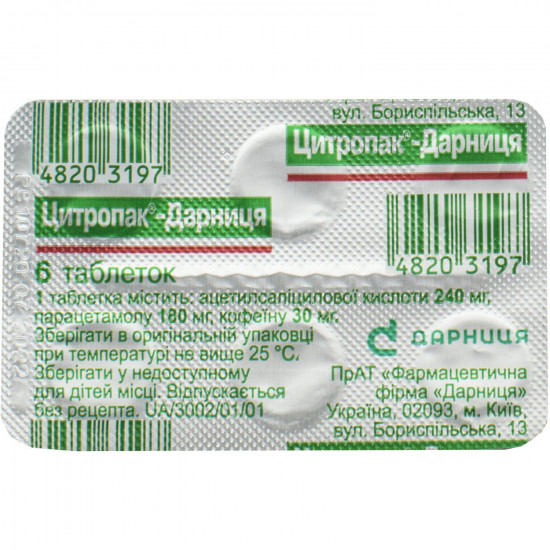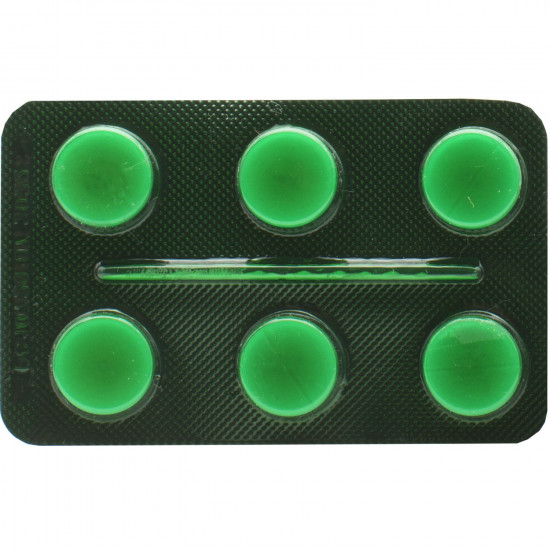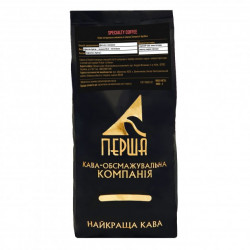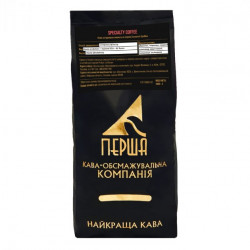



- Stock: In Stock
- Model: 182027
0% Customers recommend this product
-
5 Awesome0%
-
4 Great0%
-
3 Average0%
-
2 Bad0%
-
1 Poor0%
Reviews Over Tsitropak-Darnitsa of the tab. No. 6
- (0)
Total Reviews (0)
click here write review to add review for this product.
Report this review.
Description
Pharmacological properties
Pharmacodynamics. the combined drug.
Thanks to existence in a tablet of acetylsalicylic acid and paracetamol medicament has anti-inflammatory, febrifugal and analgetic effects.
Components which are a part of medicament enhance effect of each other.
Acetylsalicylic acid has analgeziruyushchy, febrifugal and anti-inflammatory effect, reduces the pain which is especially caused by inflammatory process and also moderately suppresses aggregation of thrombocytes and a thrombogenesis, improves microcirculation in the inflammation center.
Antipyretic effect of acetylsalicylic acid is implemented bythrough central nervous system by oppression of synthesis of PGF 2 in a hypothalamus in response to influence of endogenous pyrogens.
Analgeziruyushchy action has both peripheral, and central origin: peripheral effect — oppression of synthesis of prostaglandins of the inflamed fabrics; the central effect — influence on the centers of a hypothalamus.
Paracetamol renders toanalgetic, febrifugal and weak anti-inflammatory action which is connected with its influence on the center of thermal control in a hypothalamus and less significant ability to inhibit synthesis of prostaglandins in fabrics.
Kofein increases reflex irritability of a spinal cord, excites the respiratory and hemodynamic centers, expands blood vessels of skeletal muscles, a brain, heart, kidneys, reduces aggregation of thrombocytes; reduces drowsiness, feeling of fatigue, increases intellectual and physical effeciency. Caffeine weakens effect of somnolent and narcotic substances, strengthens effect of analgetics and febrifuges.
In this combination caffeine in a low dose has practically no promoting effect on central nervous system, however contributes to normalization of a tone of vessels of a brain and acceleration of a blood-groove.
Pharmacokinetics. It was not studied.
Indication
Therapy of a weak or moderate pain syndrome: at head or a toothache, primary dysmenorrhea, migraine, an arthralgia, neuralgia, diseases which are followed by a hyperthermia of various etiology (as febrifuge).
Use
by Tsitropak-darnits'sare appointed on 1 tablet by 2–3 times a day after a meal. the maximum daily dose — 6 tablets (on 2 tablets 3 times a day). it is not necessary to take a pill of tsitropak-darniyets more than 5 days as anesthetic and more than 3 days — as febrifuge.
not to exceed the recommended dose. Not to accept along with other medicines containing paracetamol.
Contraindication
- Hypersensitivity to any of medicament components, hypersensitivity to other salicylates; existence in the anamnesis of instructions on oh, urticaria or rhinitis which are caused by use of acetylsalicylic acid or others npvp; GIT erosive cankers (in an aggravation phase), gastrointestinal bleeding; a blood disease, hemophilia, hemorrhagic diathesis, a prothrombinopenia, anemia, a leukopenia, the increased tendency to bleedings, thrombosis, thrombophlebitis, hemorrhagic diseases; heavy renal or liver failure, portal hypertensia, congenital hyperbilirubinemia; deficit glyukozo-6-fosfatdegidrogenazy; organic diseases of a cardiovascular system (including profound atherosclerosis), disturbance of warm conductivity, Bouveret's disease, heavy ag, heavy course of an ischemic heart disease, acute myocardial infarction, dekompensirovanny heart failure, tendency to an angiospasm; glaucoma, hyperthyroidism, acute pancreatitis, prostatauxe, severe forms of diabetes; not to apply together with Mao's inhibitors and for 2 weeks after phase-out of inhibitors of Mao, it is contraindicated to patients who accept tricyclic antidepressants or blockers of β-adrenoceptors; alcoholism, epilepsy, hyperexcitability, sleep disorder; the combined use with a methotrexate in a dose of ≥15 mg/week; surgical interventions which are followed by considerable bleeding; the age is more senior than 60 years.
Side effects
from central nervous system: dizziness, headache, tremor, involuntary muscular contractions, psychomotor initiation, disturbance of orientation and attention, insomnia, sleep disorder, nervousness, irritability, hyperexcitability, concern, uneasiness, general weakness, paresthesias, fear;
from sense bodys: disorder of vision, sonitus, deafness;
from a GIT: abdominal pain, a gastralgia, nausea, vomiting, dyspepsia, heartburn, in some cases — inflammation of a GIT, GIT erosive cankers, in isolated cases — gastrointestinal bleedings and perforation with the corresponding laboratory indicators and clinical manifestations;
from a liver and bilious ways: hepatotoxicity, an abnormal liver function, increase in activity of liver enzymes, as a rule, without development of jaundice, a tranzitorny liver failure with increase in level of transaminases of a liver; gepatonekroz (dose-dependent effect);
from an endocrine system: a hypoglycemia, up to a hypoglycemic coma;
from a cardiovascular system: increase in the ABP, tachycardia, arrhythmia, heart consciousness, cardiopalmus;
from bodies of a hemopoiesis: hemorrhages can lead to acute and chronic posthemorrhagic anemia / an iron deficiency anemia (as a result of the so-called latent microbleeding) with the corresponding laboratory manifestations and clinical symptoms, such as asthenia, pallor of integuments, hypoperfusion; sulfhemoglobinemia and methemoglobinemia (cyanosis, short wind, heartache), hemolytic anemia. At prolonged use in high doses — aplastic anemia, a pancytopenia, a neutropenia, a leukopenia;
from the system of fibrillation: decrease in aggregation of thrombocytes, hypocoagulation, hemorrhagic syndrome, purpura, agranulocytosis, thrombocytopenia; bruises or bleedings (such bleedings as intraoperative bleedings, hematomas, nasal bleedings, bleeding of gums, bleedings from bodies of an urinogenital system were observed); seldom or very seldom — serious bleedings, such as bleedings from a GIT, brain hemorrhages (especially at patients from uncontrollable AG and/or at simultaneous use of anti-hemostatics) which in rare instances could threaten life potentially;
from respiratory organs: dispnoe, dry cough, a bronchospasm at the patients sensitive to acetylsalicylic acid and other NPVP;
from an urinary system: nephrotoxicity, damage of kidneys with papillary necrosis, at reception in high doses — renal colic, interstitial nephrite;
change from skin and mucous membranes: a malignant exudative erythema (Stephens's syndrome — Johnson), a toxic epidermal necrolysis (Lyell's disease), rhinitis, congestion of a nose;
disturbance from the immune system: reactions of hypersensitivity, including rash on skin and mucous membranes (including generalized rash, erythematic, spotty urtikarnaya), urticaria, a skin itching, hypostasis, a Quincke's disease, a multiformny exudative erythema (including Stephens's Syndrome — Johnson), a toxic epidermal necrolysis (Lyell's disease), an anaphylaxis, an acute anaphylaxis, not cardiogenic fluid lungs.
Special instructions
For short-term use. not to exceed the appointed doses. not to apply along with other medicaments containing paracetamol.
does not recommend to applywithout consultation of the doctor Tsitropak-Darnits more than 5 days as analgeziruyushchy means and 3 days — as febrifuge.
Because acetylsalicylic acid suppresses aggregation of thrombocytes and this effect remains for several days after use, medicament can increase tendency to bleedings on an extent and after surgical interventions (including small surgeries, for example odontectomy). The patient before surgical intervention has to warn the doctor about administration of medicament in advance. Before planned surgical interventions it is necessary to stop administration of medicament for 5–7 days before operation.
Acetylsalicylic acid in low doses reduces removal of uric acid. At patients with the corresponding tendency it can provoke a gout attack in some cases. With care the medicament is taken in gout and diseases of a liver.
during treatment should refuse alcohol intake (increase in risk of gastrointestinal bleeding).
needs to use Drug with extra care in the following cases: gastrointestinal ulcers in the anamnesis and also a chronic or recurrent peptic ulcer; at the accompanying treatment by anticoagulants; deterioration in function of kidneys; deterioration in function of a liver, congenital hyperbilirubinemias (Gilbert's syndromes, Dubina — Johnson and the Rotor); at patients of advanced age.
Sick with functional unsufficiency of hepatic and kidneys a dose of medicament needs to lower or increase an interval between receptions. In a renal failure and a liver the interval between receptions has to make not less than 8 h
As acetylsalicylic acid, as well as all non-selective NPVP, causes irritation of a mucous membrane of a GIT, the medicament should be taken only after a meal, washing down with water, alkaline mineral waters, Natrii hydrocarbonas solution (it is the best of all — milk).
At long use of medicament should check presence of blood in Calais for definition of ulcerogenic action and to do blood tests (influence on aggregation of thrombocytes, some anticoagulating activity). medicament it is desirable for p to appoint
At a hyperthermia only in case of inefficiency of other analgetics-antipyretics as there is a risk of development of a syndrome of Ray. If owing to administration of medicament there is vomiting, then it is necessary to assume development of a syndrome of Ray.
With care use medicament for treatment of patients with allergic rhinitis, polipozy a nose, a small tortoiseshell.
At patients with allergic complications, including with OH, allergic rhinitis, a small tortoiseshell, a skin itching, hypostasis of a mucous membrane and polipozy a nose and also in combination with persistent infections of airways and at patients with hypersensitivity to NPVP against the background of medicament treatment the development of a bronchospasm or attack OH is possible.
Concerning paracetamol: before use of medicament it is necessary to consult to the doctor if the patient uses warfarin or similar medicaments which have anticoagulating effect.
Risk of overdose the greatest at patients with not cirrhotic alcoholic disease of a liver. Drug can affect results of laboratory researches on content in blood of glucose and uric acid.
to the Patients accepting analgetics every day in arthritises of an easy form needs to consult with the doctor. At patients with the heavy infections, such as sepsis which are followed by decrease in level of glutathione at intake of paracetamol the risk of developing of a metabolic acidosis increases. Symptoms of a metabolic acidosis are the deep, speeded-up or complicated breath, nausea, vomiting, loss of appetite. It is necessary to see immediately a doctor in case of these symptoms.
during medicament treatment is not recommended to take the drinks containing caffeine (coffee, tea) in excessive quantity. It can lead to problems with a dream, the tremor unpleasant to feeling behind a breast because of heartbeat.
not to exceed the specified doses.
not to take the medicament with other means containing paracetamol.
If symptoms do not disappear, it is necessary to see a doctor.
If the headache becomes a constant, it is necessary to see a doctor.
Rather acetylsalicylic acid: at patients with renal failures or patients with disturbances of blood circulation to apply about care (for example pathology of vessels of a kidney, stagnant heart failure, a hypovolemia, extensive operations, sepsis or the profound bleedings) as acetylsalicylic acid can also increase risk of a renal failure and emergence of OPN.
Ibuprofen can reduce inhibitory effect of acetylsalicylic acid on aggregation of thrombocytes. In case of use of medicament before reception of an ibuprofen as anesthetic the patient has to consult with the doctor.
should not use the medicaments containing acetylsalicylic acid at children with a SARS which is followed or is not followed by fervescence. In some viral diseases, especially flu A, flu B and chicken pox, there is a risk of development of a syndrome of Ray at which urgent medical intervention is required. The risk can be raised if to apply acetylsalicylic acid as the accompanying medicine, however relationship of cause and effect in this case is not proved. If the specified states are followed by long vomiting, it can be sign of a syndrome of Ray.
Use during pregnancy and feeding by a breast
Drug is not used during pregnancy.
Acetylsalicylic acid has teratogenic effect; at use in the I trimester of pregnancy leads to a malformation — splitting of the upper sky; in the III trimester — to slowing down of patrimonial activity (inhibition of synthesis of prostaglandins), closing of an arterial channel at a fruit that serves as the cause of a hyperplasia of pulmonary vessels and hypertensia in vessels of a small circle of blood circulation; a renal failure with possible subsequent development of a renal failure with oligogidramniony; risk of extension of a bleeding time, antiagregantny effect which can arise even after use in very low doses. Caffeine increases risk of a spontaneous abortion.
for treatment should stop feeding by a breast.
Drug gets into breast milk that increases risk of developing of bleedings at children owing to dysfunction of thrombocytes.
Children. Aged up to 16 years the use of medicament without availability of special indications (disease of Kawasaki) is contraindicated to children.
Ability to influence speed of response at control of vehicles or work with other mechanisms. At use of medicament in high doses it is necessary to abstain from control of vehicles or work with other mechanisms owing to possible side reactions from central nervous system (dizziness, psychomotor initiation and disturbance of orientation and attention).
Interaction
Acetylsalicylic acid
Combination which should be applied with care
Simultaneous use of an ibuprofen interferes with irreversible inhibition of thrombocytes acetylsalicylic acid. Treatment by an ibuprofen of patients with risk of cardiovascular diseases can limit cardiotyre-tread effect of acetylsalicylic acid.
NPVP, corticosteroids — simultaneous use increases risk of development of side effects from a GIT.
System GKS (except a hydrocortisone) which apply to replacement therapy in Addison's disease, during treatment by corticosteroids reduce the level of salicylates in blood and increase risk of overdose after the end of therapy.
Spironolactonum, furosemide, antihypertensives — decreases efficiency of these drugs.
Heparin, oral anticoagulants, reserpine, steroids, hypoglycemic means, insulin — amplifies effect of these drugs.
Anticoagulants, trombolitik — risk of developing bleedings increases.
Acetylsalicylic acid strengthens effect of Phenytoinum.
At simultaneous use with valproic acid acetylsalicylic acid forces out it from communication with blood plasma proteins, increasing toxicity of the last.
Metoclopramidum — accelerates absorption of acetylsalicylic acid.
Digoxin — decreases concentration of digoxin in blood plasma.
Simultaneous use with uricosuric means, such as benzbromaron, probenetsid, reduces effect of removal of uric acid (thanks to the competition of removal of uric acid renal tubules).
At use with selective serotonin reuptake inhibitors the risk of developing gastrointestinal bleeding owing to possible effect of synergism increases.
Ethanol — promotes injury of a mucous membrane of a GIT and prolongs a bleeding time owing to synergism of acetylsalicylic acid and ethanol.
APF Inhibitors in combination with acetylsalicylic acid in high doses cause decrease in filtration in balls owing to inhibition of vazodilatatorny prostaglandins and decrease in antihypertensive effect.
Contraindication for interaction
Use of a methotrexate in doses of ≥15 mg/week increases hematologic toxicity of a methotrexate (decrease in renal clearance of a methotrexate by anti-inflammatory agents and replacement by methotrexate salicylates from communication with blood plasma proteins).
Paracetamol
At simultaneous use of paracetamol with hepatotoxic means increases toxic impact of medicaments on a liver.
Barbiturates, rifampicin, Salicylamidum, antiepileptic medicaments and other stimulators of microsomal oxidation — these medicaments promote formation of the toxic metabolites of paracetamol influencing function of a liver.
Barbiturates reduce febrifugal effect of paracetamol.
Simultaneous use of paracetamol in high doses with an isoniazid increases risk of development of a hepatotoxic syndrome.
Metoclopramidum, domperidon — accelerates paracetamol absorption.
Derivative coumarin (warfarin) — at prolonged use of paracetamol the risk of developing bleedings increases.
Colestyraminum — reduces paracetamol absorption.
under the influence of paracetamol time of removal of chloramphenicol increases by 5 times.
Paracetamol reduces efficiency of diuretics.
Anticonvulsant medicaments (including Phenytoinum, barbiturates, carbamazepine) which stimulate activity of microsomal enzymes of a liver, can strengthen toxic effect of paracetamol on a liver owing to increase in transformation of medicament into hepatotoxic metabolites.
Ethanol — raises paracetamol hepatotoxicity.
not to applyalong with alcohol.
Kofein
Simultaneous use of caffeine with MAO inhibitors can cause dangerous increase in the ABP.
Kofein increases effect (improves bioavailability) analgetics-antipyretics, exponentiates effects of derivatives of xanthine, alpha and beta-adrenergic agonists, psychogogic means.
Cimetidinum, hormonal contraceptives, an isoniazid strengthen effect of caffeine.
Kofein reduces effect of opioid analgetics, anxiolytics, hypnotic medicaments and sedatives, is an antagonist of the anesthetics and other medicaments oppressing central nervous system, the competitive antagonist of medicaments of adenosine, ATP.
At simultaneous use of caffeine with thyritropic means — the thyroid effect increases.
Kofein reduces concentration of lithium in blood.
Kofein accelerates ergotamine absorption.
OverdoseSymptoms of overdose can be shown by
at prolonged use of medicament or in the doses many times exceeding recommended.
As Tsitropak-Darnitsa is the combined drug, the overdose it should be considered concerning each active ingredient which is its part.
Acetylsalicylic acid
Poisoning with salicylates usually arises at concentration in blood plasma of 350 mg/l (2.5 mmol/l). The greatest number of lethal outcomes is noted at concentration of acetylsalicylic acid in blood plasma 700 mg/l (5.1 mmol/l). Single application in a dose of 100 mg/kg of body weight most likely will not entail serious poisoning.
overdose Symptomatology. Development of such side reactions as vomiting, dehydration, sonitus, dizziness, deafness, the increased sweating, feeling of heat in extremities, a cardiopalmus, premature ventricular contraction and a hyperventilation, disturbance of acid-base balance of blood is very often observed. The combination of a respiratory alkalosis and metabolic acidosis to the normal or increased level rn arterial blood is noted at adults and children. Acidosis can promote increase in transportation of salicylates through GEB.
byLess often observe development of such side reactions as vomiting with blood impurity, a hyper pyrexia, a hypoglycemia, a hypopotassemia, thrombocytopenia, increase in a prothrombin time, intravascular coagulation, a renal failure, a fluid lungs of not cardial genesis. Development of side reactions from central nervous system is also possible: disorientation, psychomotor excitement or oppression of central nervous system, drowsiness, consciousness disturbances, dizziness, tremor, hyperreflexia, spasms, coma.
overdose Symptoms caused by acetylsalicylic acid
Toxicity of salicylates can be result of intoxication owing to prolonged use of therapeutic doses or acute intoxication (at use of 100 mg/kg/days within more than 2 days) that potentially threatens life (from accidental ingestion by children to accidental poisoning).
Chronic poisoning with salicylates can passasymptomatically as has no specific symptoms. Intoxication salicylates of moderate severity, or a salitsilizm, usually develops only after repeated use in high doses.
Symptoms: dizziness, sonitus, deafness, the increased sweating, nausea, vomiting, a headache and oppression of consciousness can be controlled by a dose decline. Sonitus can arise at plasma concentration of 150-300 mkg/ml. Heavier side effects arise at concentration of 300 mkg/ml. The main feature of acute poisoning is heavy disturbance of acid-base balance which can differ with age and weight of intoxication. The most common symptom at children is the metabolic acidosis. Weight of poisoning cannot be estimated, considering only these concentration in blood plasma. Absorption of acetylsalicylic acid can slow down owing to slowing down of gastric emptying, forming of concrements in a stomach or as a result of use of the medicaments covered with an enterosoluble cover.
Emergency aid in poisoning with acetylsalicylic acid is defined by severity, a stage and clinical symptoms and corresponds to standard methods of rendering emergency aid in poisonings. Primary measures have to be allocated for removal acceleration of medicine and also for recovery of electrolytic and acid-base balance.
as a result of complex pathophysiological effects of poisoning with salicylates some symptoms and laboratory changes can arise.
Poisoning easy and moderate severity: a tachypnea, a hyperventilation, a respiratory alkalosis, the increased sweating, nausea, vomiting. Datas of laboratory: alkalosis, alkali reaction of urine.
Serious poisoning: a respiratory alkalosis with a compensatory metabolic acidosis, a hyper pyrexia, sonitus, deafness. Respiratory system: from a hyperventilation, not cardiogenic fluid lungs to an apnoea and asphyxia; datas of laboratory — an alkalosis, alkali reaction of urine. Cardiovascular system: from disturbances of a warm rhythm, arterial hypotension to cardiac arrest. Loss of liquid and electrolytes: dehydration, oliguria, renal failure. Datas of laboratory — a hypopotassemia, a hypernatremia, a hyponatremia, change of function of kidneys, lengthening of a prothrombin time, a prothrombinopenia. Disturbance of exchange of glucose, a ketosis are laboratory shown in the form of a hyperglycemia, a hypoglycemia (especially at children), increases in level of ketone ph. of a GIT: gastrointestinal bleedings. Changes from blood: from oppression of function of thrombocytes to coagulopathies. Neurologic: toxic encephalopathy and oppression of central nervous system — from slackness, oppression of consciousness to a coma and an attack of spasms.
overdose Symptoms caused by paracetamol. Damage of a liver is possible at adults who accepted ≥10 g of paracetamol, and at children who accepted 150 mg/kg of body weight.
At patients with risk factors (long-term treatment by carbamazepine, phenobarbital, Phenytoinum, Primidonum, rifampicin, a St. John's wort or other medicines displaying liver enzymes; regular intake of ethanol in excess quantities; the glutationovy cachexia (digestive disturbances, a mucoviscidosis, HIV infection, hunger, a cachexia)) can lead reception of ≥5 g of paracetamol to damage of a liver.
overdose Symptomatology. For the first 24 h there are nausea, vomiting, anorexia, an abdominal pain, pallor of skin. During 12–48 h, damages of a liver, disturbance of metabolism of glucose and a metabolic acidosis can be shown. At considerable overdose of disturbance from a liver can entail encephalopathy, a hypoglycemia, brain hypostasis, a coma, a lethal outcome. OPN together with acute necrosis of tubules can develop even in the absence of severe damage of kidneys. Also it was reported about development of such disturbances as the increased sweating, drowsiness, consciousness disturbance, tachycardia, premature ventricular contraction, a tremor, hyperreflexia, spasms, cardiac arrhythmias, pancreatitis, psychomotor excitement or oppression of central nervous system. At reception of high doses from an urinary system: nephrotoxicity (renal colic, interstitial nephrite, capillary necrosis); from central nervous system — dizziness, orientation disturbance.
Treatment: gastric lavage with the subsequent use of activated carbon, symptomatic therapy. Methionine use orally or Acetylcysteinum in/in is effective during 48 h after overdose. It is necessary to take also all-supporting measures. If necessary to apply blockers of alpha adrenoceptors.
overdose Symptoms caused by caffeine. From the central and peripheral nervous system: acrimony, nervousness, concern, insomnia, dizziness, the increased emotional excitability, involuntary muscular contractions, spasms, the accelerated breath. From a GIT: stomach or stomach pain. From a cardiovascular system: tachycardia, arrhythmia. Others: rushes of blood suit, frequent urination.
Treatment. Gastric lavage; in case of oppression of an emetic reflex appoint ipecacuanha drugs, activated carbon, a high cleansing enema, correction of acid-base balance, blood plasma electrolytes, an artificial diuresis, oxygenotherapy, a hemodialysis in hard cases. Symptomatic therapy. In spasms apply diazepam.
byDuring the first hours acute poisoning appoint Acetylcysteinum if perhaps orally — in a dose of 140 mg/kg if it is orally impossible — in a dose of 150 mg/kg for the first in/in introductions, then a dose Storage conditions
>
In original packing at a temperature not above 25 °C.
Specifications
| Characteristics | |
| Active ingredients | Acetylsalicylic acid, Caffeine, Paracetamol |
| Applicant | Darnitsa |
| Code of automatic telephone exchange | N02BA51 Acetylsalicylic acid, combinations without psikholeptik |
| Interaction with food | Later |
| Light sensitivity | Not sensitive |
| Market status | Traditional |
| Origin | Chemical |
| Prescription status | Without prescription |
| Primary packing | blister |
| Producer | DARNITSA CIAO PHARMACEUTICAL. FIRM |
| Quantity in packing | 6 tablets |
| Release form | tablets for internal use |
| Route of administration | Oral |
| Sign | Domestic |
| Storage temperature | from 5 °C to 25 °C |
| Trade name | Tsitropak |




















